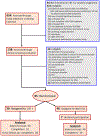Cognitive behavioral therapy for insomnia in veterans with gulf war illness: Results from a randomized controlled trial
- PMID: 33549595
- PMCID: PMC8217272
- DOI: 10.1016/j.lfs.2021.119147
Cognitive behavioral therapy for insomnia in veterans with gulf war illness: Results from a randomized controlled trial
Abstract
Aims: To examine whether cognitive behavioral therapy for insomnia (CBT-I), delivered by telephone, improves sleep and non-sleep symptoms of Gulf War Illness (GWI).
Main methods: Eighty-five Gulf War veterans (21 women, mean age: 54 years, range 46-72 years) who met the Kansas GWI case definition, the Centers for Disease Control and Prevention (CDC) case definition for Chronic Multisymptom Illness (CMI), and research diagnostic criteria for insomnia disorder were randomly assigned to CBT-I or monitor-only wait list control. Eight weekly sessions of individual CBT-I were administered via telephone by Ph.D. level psychologists to study participants. Outcome measures included pre-, mid-, and post-treatment assessments of GWI and insomnia symptoms, subjective sleep quality, and continuous sleep monitoring with diary. Outcomes were re-assessed 6-months post-treatment in participants randomized to CBT-I.
Key findings: Compared to wait list, CBT-I produced significant improvements in overall GWI symptom severity, individual measures of fatigue, cognitive dysfunction, depression and anxiety, insomnia severity, subjective sleep quality, and sleep diary outcome measures. The beneficial effects of CBT-I on overall GWI symptom severity and most individual GWI symptom measures were maintained 6-months after treatment.
Significance: GWI symptoms have historically been difficult to treat. Because CBT-I, which is associated with low stigma and is increasingly readily available to veterans, improved both sleep and non-sleep symptoms of GWI, these results suggest that a comprehensive approach to the treatment of GWI should include behavioral sleep interventions.
Keywords: Chronic multisymptom illness; Cognitive behavioral therapy; Gulf war illness; Insomnia; Telehealth; Veteran.
Published by Elsevier Inc.
Conflict of interest statement
Declaration of competing interest
The authors have no competing interests.
Figures




Similar articles
-
Insomnia Severity, Subjective Sleep Quality, and Risk for Obstructive Sleep Apnea in Veterans With Gulf War Illness.Mil Med. 2016 Sep;181(9):1127-34. doi: 10.7205/MILMED-D-15-00474. Mil Med. 2016. PMID: 27612364 Free PMC article.
-
Veterans with Gulf War Illness perceptions of management strategies.Life Sci. 2021 Aug 15;279:119219. doi: 10.1016/j.lfs.2021.119219. Epub 2021 Feb 13. Life Sci. 2021. PMID: 33592197
-
Cognitive behavioral therapy for insomnia in posttraumatic stress disorder: a randomized controlled trial.Sleep. 2014 Feb 1;37(2):327-41. doi: 10.5665/sleep.3408. Sleep. 2014. PMID: 24497661 Free PMC article. Clinical Trial.
-
Progression of intervention-focused research for Gulf War illness.Mil Med Res. 2019 Oct 18;6(1):31. doi: 10.1186/s40779-019-0221-x. Mil Med Res. 2019. PMID: 31627737 Free PMC article. Review.
-
Effects of cognitive-behavioral therapy for insomnia compared with controls among cancer survivors: a systematic review and meta-analysis of randomized trials.BMC Cancer. 2025 May 14;25(1):871. doi: 10.1186/s12885-025-14192-y. BMC Cancer. 2025. PMID: 40369457 Free PMC article.
Cited by
-
Comprehensive examination of resting state fMRI connectomics yields new insights into brain function deficits in Gulf War illness after accounting for heterogeneity in brain impairment across the ill veteran population.Neuroimage Rep. 2024 Jun 4;4(3):100209. doi: 10.1016/j.ynirp.2024.100209. eCollection 2024 Sep. Neuroimage Rep. 2024. PMID: 40568571 Free PMC article.
-
Yoga is effective for treating chronic pain in veterans with Gulf War Illness at long-term follow-up.BMC Complement Med Ther. 2023 Sep 13;23(1):319. doi: 10.1186/s12906-023-04145-y. BMC Complement Med Ther. 2023. PMID: 37704984 Free PMC article. Clinical Trial.
-
Investigating a clinically informed sleep disturbance threshold for physical and mental health among Gulf War Illness veterans.Sleep Adv. 2024 Mar 28;5(1):zpae018. doi: 10.1093/sleepadvances/zpae018. eCollection 2024. Sleep Adv. 2024. PMID: 38616799 Free PMC article.
-
Recent Research Trends in Neuroinflammatory and Neurodegenerative Disorders.Cells. 2024 Mar 14;13(6):511. doi: 10.3390/cells13060511. Cells. 2024. PMID: 38534355 Free PMC article. Review.
-
Orexin dual receptor antagonists, zolpidem, zopiclone, eszopiclone, and cognitive research: A comprehensive dose-response meta-analysis.Front Hum Neurosci. 2023 Jan 9;16:1029554. doi: 10.3389/fnhum.2022.1029554. eCollection 2022. Front Hum Neurosci. 2023. PMID: 36699960 Free PMC article. Review.
References
-
- Institute of Medicine, Gulf War and Health: Volume 8 - Health Effects of Serving in the Gulf War, 2010. (Washington, D.C.).
-
- Kang HK, Li B, Mahan CM, Eisen SA, Engel CC, Health of US veterans of 1991 Gulf War: a follow-up survey in 10 years, J Occup Environ Med. 51 (2009) 401–410. - PubMed
-
- Research Advisory Committee on Gulf War Veterans’ Illnesses (RAC-GWVI). Gulf War Illness and the Health of Gulf War Veterans. Washington, D.C., 2008.
-
- Fukuda K, Niesenbaum R, Stewart G, et al., Chronic multisymptom illness affecting Air Force veterans of the Gulf War, JAMA. 280 (1998) 981–988. - PubMed
-
- Goss Gilroy Inc. Health Study of Canadian Forces Personnel Involved in the 1991 Conflict in the Persian Gulf. Ottawa, Canada: Gulf War Illness Advisory Committee; 1998.
MeSH terms
Grants and funding
LinkOut - more resources
Full Text Sources
Other Literature Sources
Medical
Miscellaneous

